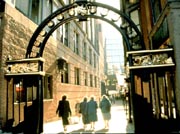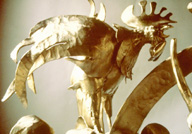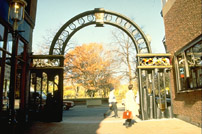



Boylston Place Gateway links Boston Common with the Theater
District. Its main purpose is to identify the entrance to a public
place and to welcome people to enter. It furthermore serves as
a bridge to varying styles of architecture. Like much of this
artist's work, it operates on many different levels.
Hammered to shape from hot metal, and
hot-dip galvanized to endure for generations, the gateway defies
our common conceptions of metallic forms. Says Gerakaris, "metal
can also be made to flow and move in graceful curves...it can
be given an organic feel to express warmth and human feelings
and made to reflect the wholeness of life. There is flow to the
curtain-like forms, which make reference to the stage curtains
of the nearby Theater District. Where the curtains join the arch
on one side, there is a bronze frieze that depicts the theatrically-inclined
dog, cat, rooster and donkey from the children's tale of the Bremen
Town Musicians. On the opposite frieze, greeting these animals
are corresponding creatures from local lore, such as the swan
of the Boston Garden's swan boats, the mounted policeman's horse,
etc.
While this child-like motif may seem comforting to many who pass
it daily, there is a much more subtle and ironic allusion to the
nature of life by the overall form of the gateway being identical
to the gravestones in the old buryingground directly across Boylston
Street. The Gateway's initial impression is to be of a flowing
and easy to identify arching form, but for the thousands of people
who daily pass its way, it contains a tremendous amount of detail
serving to conjure up a feast of forms and imagery from the area.



